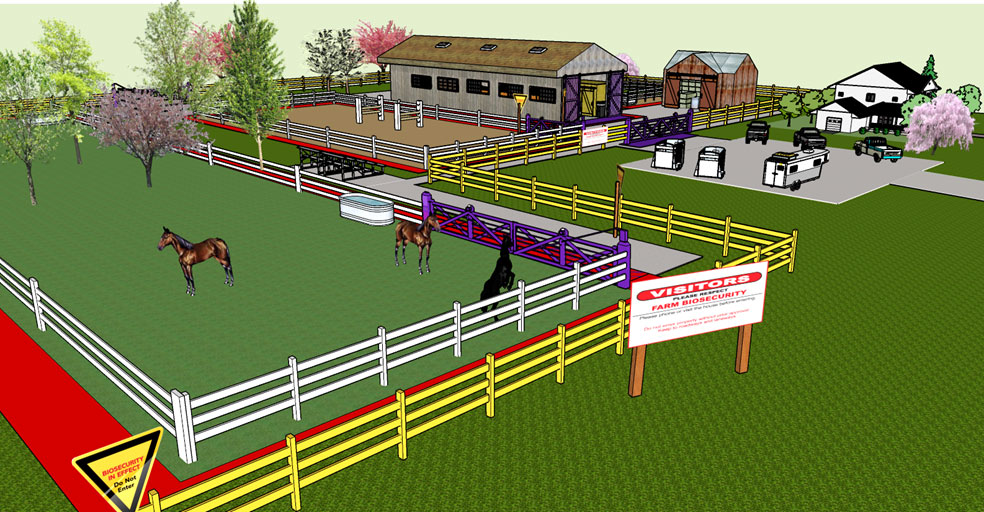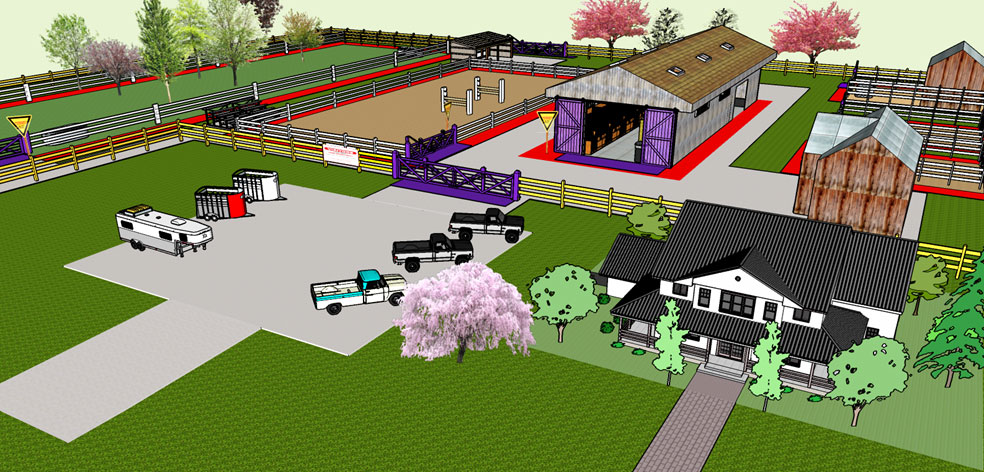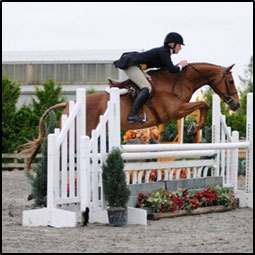National Farm and Facility Level Biosecurity User Guide for the Equine Sector
Section 7: Access management
Goal: Management and control of farm or facility access and identified risk areas limit disease introduction and spread on-site and enable the implementation of biosecurity practices.
Description: Access management refers to the use of physical barriers and/or procedural measures to reduce the transmission of pathogens onto, within and between horse farms and facilities by people, horses, equipment, materials, vehicles and trailers.
Essentials of access management include:
- Identifying pathways for disease transmission;
- Interrupting or blocking pathways of disease transmission;
- Controlling unwanted or unnecessary access to a farm, facility and horses;
- Managing the movement of people, horses and equipment on site; and
- Employing biosecurity measures to reduce the risk of exposure to and spread of disease should an outbreak occur.
Consideration given to proper access management in the early implementation of biosecurity plans provides an improved capability to respond should disease occur.
7.1 Movement onto and within farms and facilities (zones)
Goal: Establish and identify biosecure zones, controlled access points, and pathways to control access to the premises, barns and horses and to minimize pathogen transmission by animals, people, vehicles, trailers and equipment.
Description: Biosecure zones simply allow the separation and protection of horses and areas used for their care from sources of pathogens by mapping out and then controlling movements of people, animals, equipment and materials through zones. It starts with dividing a facility into management areas and identifying access points (controlled access points) to each area. Management areas might include the site as a whole, an individual barn, or arenas and other locations, including wash stalls and feed rooms. Controlled access points should be equipped with the necessary materials and supplies to implement biosecurity procedures.
The design of zones and applicable biosecurity requirements should reflect the specific disease risks and the management goals of the equine owner, custodian or facility manager. Properly established biosecurity zones facilitate day-to-day activities without the unnecessary interruption associated with application of dissimilar biosecurity procedures. In many countries, including Canada, zones for controlling movement and biosecurity management, are called either controlled access zones or restricted access zones based on the risk of activities carried out within them.
- A controlled access zone is a designated area that contains the land, buildings, equipment and infrastructure involved in the care and management of horses where access and movements are controlled. Entry is restricted and managed through a controlled access point. The controlled access zone is often the first zone that is entered on a farm or facility and frequently includes laneways, equipment, storage sheds, and riding arenas, although some of these may be in the restricted access zone in other facilities. It usually excludes the house and office space of the farm owner and manager. The controlled access zone may include pastures and barns that horses are not currently occupying. A controlled access zone has its own specific biosecurity protocol and often encompasses the restricted access zone(s).
- A restricted access zone is a designated area where horses commonly reside (are stabled, housed, pastured) and where access to people, equipment and materials is further restricted. The zone(s) include the pens, barns, and pastures, as well as separation areas used for new, visiting and sick horses. The layout and management practices of individual farms and facilities will determine whether manure storage and other production infrastructure directly involved in animal care and maintenance should be included within the restricted access zone.
It is important to remember that equine owners and custodians may decide to use a single zone to manage biosecurity on a farm or facility, depending on its complexity and risk factors that exist.
Figure 8: Zoning on a horse facility:

Description for image – Figure 8: Zoning on a horse facility
A picture of a horse facility surrounded by a fence painted yellow. Outside the fenced area in the bottom right is a house. To the left of the house is a parking area (concrete pad) with a number of horse trailers and pick-up trucks parked on it. Between the parking area and the horse barns and grounds is a large closed gate. In the lower left of the picture are two biosecurity signs. One is a large rectangular white sign with the text "Visitors please respect farm biosecurity. Phone or visit the house before entering. Do not enter property without prior approval. Keep to laneways and pathways." A smaller yellow sign in the shape of a yield sign has the text: "Biosecurity in effect. Do not enter." Behind the gate starting from the left side is a horse pasture surrounded by a white wood fence with a gate. There are a number of horses in the pasture and a large water trough. To the right is a horse arena surrounded by a fence, a gate and some bleacher seats. Behind the arena is a covered manure storage area on a concrete pad. To the right of the arena is a large horse barn with the barn doors open at the front. To the right of the barn are fenced turnout pens. A storage barn is located below the turnout pens. Hard surfaces surround the horse pasture, barn and storage barn.
A simple horse facility demonstrating the concept of two biosecurity zones. The controlled access zone (yellow fenced area) establishes a boundary between everything outside the facility and areas of the property involved in horse care and management. It provides the ability to manage the risks of the introduction of disease into areas where it may be easily transferred to horses and reduce the spread of disease off of the property. Storage areas for feed, bedding and manure and bleachers for viewing the arena are located in this zone. Restricted access zones (areas bounded in red) require stricter biosecurity and limit direct access to horses or the areas that they may reside. Controlled access points (purple gates) and signage assist in managing and directing traffic flow into and out of the controlled and restricted access zones. Parking for visitors is established outside the controlled access zone and a separate driveway and parking area is established for the property owner's house.
Figure 9: Zoning on a horse facility

Description for image – Figure 9: Zoning on a horse facility
A picture of a horse facility surrounded by a fence painted yellow. Outside the fenced area in the bottom right is a house. To the left of the house is a parking area (concrete pad) with a number of horse trailers and pick-up trucks parked on it. Between the parking area and the horse barns and grounds is a large closed gate. Behind the gate starting from the left side is a horse pasture surrounded by a white wood fence with a gate. To the right is a horse arena surrounded by a fence, a gate and some bleacher seats. Behind the arena is a covered manure storage area on a concrete pad. To the right of the arena is a large horse barn with the barn doors open at the front. To the right of the barn are two fenced turnout pens and at the top back right corner a fenced turnout area with a small horse shelter. A storage barn is located below the turnout pens. Hard surfaces surround the horse pasture, barn and storage barn.
An alternate view of the horse facility depicted in figure 8. Clockwise from the upper left: Pastured horses are separated from other horses on the property and traffic flow minimizes interaction with resident horses. Covered manure storage is located at the back edge of the property with a dedicated controlled access point (purple gate) allowing access and manure removal, minimizing entry into the property. The arena and resident horse barns are restricted access zones. Hard-surface pathways facilitate movement around the property and completely surround the barn, which is a high traffic area.
In the upper right-hand corner, a restricted access zone surrounds a small barn (stable) and paddock area established for the care of sick or suspect horses. Separate feed, water, equipment and tack are stored here and dedicated for the care and maintenance of horses. Two day turn-out paddocks (also restricted access zones) allow separation of peer group horses. Feed and bedding are stored in the small barn adjacent to them.
Best practices:
- review farm or facility layout to determine what biosecurity risks exist with current horse stabling locations;
- establish controlled access zones and restricted access zones and, when necessary, establish segregation areas for new horses, for horses returning from off farm events, and areas for the treatment of sick horses;
- minimize unnecessary access by limiting the number of entrances (access points);
- ensure the necessary biosecurity equipment is provided at designated access points;
- establish and identify pathways to reduce the risk of disease spread by separating the movement of horses of different health status, used and new materials (bedding), visitors and farm personnel;
- maintain the pathways clean and free of potential sources of disease; and
- post biosecurity signage to guide and direct custodians and visitors.
Best practices: Large event facilities
- apply farm or facility zoning "best practices" to the degree possible;
- manage the access and movements of people and pets on-site;
- establish separate entrances and parking areas for participants and visitors;
- ensure resident horses, if present, are housed and exercised separately from visiting participant horses. If this is not possible, ensure resident horses are required to be held to the same health status as competition horses;
- encourage the use of housing that prevents nose-to-nose (direct) contact between horses;
- ensure common use areas such as wash stalls or racks prevent direct contact between horses and to the degree possible, common contact surfaces (fomites);
- stable horses in groups (cohorts) to create distinct management units with their own wash stalls, feed and equipment storage; and
- establish a segregation area for sick horses that is physically separated from the housing and exercise areas used by resident and participant horses.
7.2 Procedures for moving between zones
Goal: Establish requirements and implement procedures to manage the entry and movement of people, horses, equipment, vehicles and trailers.
Description: To achieve the benefits zones can provide depends on controlling access to the zone(s) and the application of appropriate biosecurity measures when people, horses, equipment, vehicles and trailers cross zone boundaries.
People, particularly those who have had contact with livestock or other livestock premises, and horses, primarily those that are of an unknown or lower health status, that enter the farm or facility pose a risk for the introduction of disease. Additionally, pathogens that may be present in manure, respiratory fluids, urine and blood, can contaminate equipment and trailers and transmit disease when they come into contact with horses.
The biosecurity measures required for people, equipment and horses moving across zones can be viewed as a gradient occurring at different levels based on risk. As the risk of the introduction and transmission of pathogens increases, the degree of biosecurity measures required increases.
Veterinarians can assist equine owners and custodians in assessing what risk factors exist with a particular event or facility, and how to institute practices consistent with the risk at hand.
In some facilities, biosecurity levels are identified by colour (for example, green, yellow, red). Colour-coded biosecurity signs indicate the level of biosecurity and biosecurity practices to be followed.
Basic biosecurity practices include those conducted on a daily basis as a part of normal care and husbandry. Biosecurity protocols at a basic level describe routine practices for things like personal sanitation, (for example hand washing), handling of animal waste, use of water hoses and buckets, handling feed, care and sanitation of tack and grooming supplies, and routine monitoring of health.
As the level of precaution increases, basic biosecurity practices still apply supplemented by protocols limiting access; describing the care and use of protective clothing for certain areas; stricter levels of personal sanitation between every horse, greater level of control over the hygiene of tack, grooming supplies, water pails and feed tubs, including restrictions on sharing between horses. Direct nose-to-nose contact between horses over stalls and fences would be controlled.
At an enhanced level of biosecurity, access to certain areas is restricted and controlleddue to disease, or the need for separation for any reason (for example, post-import separation). Biosecurity protocols for restricted areas include all measures mentioned above plus expanded attention to posted signs and instructions. Sanitary precautions are carefully outlined including the cleaning and disinfection of footwear and use of disinfectant footbaths.
Larger boarding stables and event venues pose an increased risk for disease transmission due to:
- increased numbers of horses;
- potential for uncontrolled commingling of horses with different health management backgrounds; and
- more frequent movement of people, horses and equipment and the associated stress of transport.
Day-to-day access management in large facilities is more difficult to accomplish, increasing the importance of vaccination programs, prescribed health standards for attendance, and monitoring the health of horses in attendance.

Best practices - People:
- train personnel on-farm and facility biosecurity procedures;
- limit non-essential traffic on the site and restrict unnecessary access to horses;
- prevent visitor access if they have had recent contact (< 48 hours) with horses suspected or known to be infected with a contagious disease;
- prevent visitor access if they have recently returned (< 5 days) from a foreign country where contact with horses or livestock has occurred;
- restrict access to horses separated from the resident herd (those that are sick and new or recently returned horses) to only those personnel necessary for their care;
- plan ahead for visitors by informing them of the farm/facility biosecurity procedures in advance of their arrival;
- schedule visitor arrivals, particularly visitors with horses of unknown health status;
- meet new and infrequent visitors at the farm/facility entrance (outside the CAZ) and provide biosecurity instructions. For frequent visitors, consider reviewing biosecurity procedures with them, e.g. twice a year, and randomly checking their compliance to procedures;
- use a visitor log to document visitor access which will assist with disease control and response activities within the industry;
- provide a means for participants to report biosecurity concerns to facility managers for action
- assign staff to monitor movements within the venue including access to barns, isolation areas and to provide guidance to participants and visitors on which areas of the venue they are allowed to access;
- restrict access to the isolation area to only those people necessary for the horses' direct care; and
- restrict access to horse management units to only those horses and participants assigned to them.
Best practices - Sanitation (people, equipment, tack)
- hand washing or the use of a hand sanitizer, combined with barrier protection (protective outer clothing or clothing changes) are effective measures for reducing disease transmission by people;
- dedicate equipment and tack to each horse (halter, lead rope, brushes, rags, water and feed buckets, hay nets, fly masks etc.);
- clearly identify dedicated equipment by labelling or colour-coding;
- clean and disinfect shared equipment between horses;
- clean and disinfect equipment at the end of the day and store in a clean location separate from other horse equipment;
- select equipment that can be easily cleaned and disinfected, where feasible: hard and non-porous surfaces (metal, fiberglass, plastic, rubber) rather than softer porous materials (wood or easily scratched synthetic material);
- dedicate equipment to areas where horses are separated from the herd while sick or for a period of observation;
- only allow equipment, tools, and vehicles that have been brought onto the site to enter a control area if it is necessary;
- ensure visitor vehicles are visibly clean prior to entry to the premises and control access zone. Can request additional measures if the vehicle is coming from an area where disease has been present;
- ensure service equipment (farrier etc.), tools and vehicles have been cleaned and disinfected prior to entry; and
- follow a stepwise procedure for cleaning and disinfection and use a registered disinfectant (Drug Identification Number) that targets the pathogens of concern.
- Date modified: